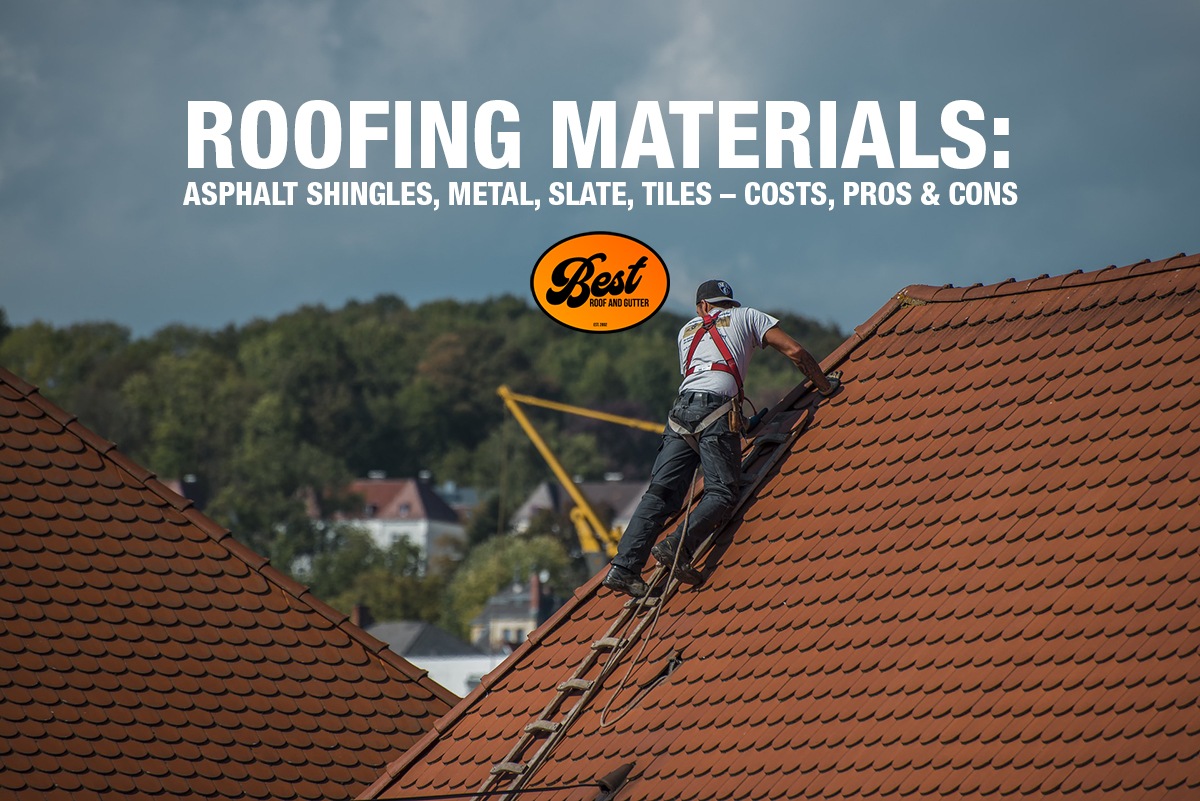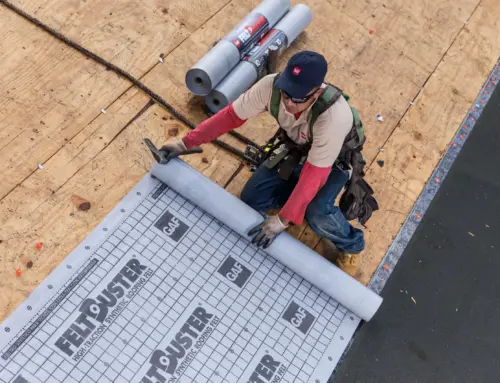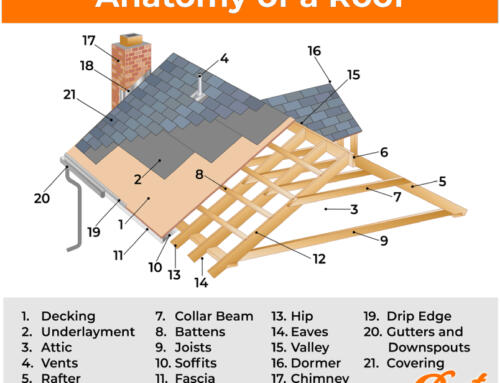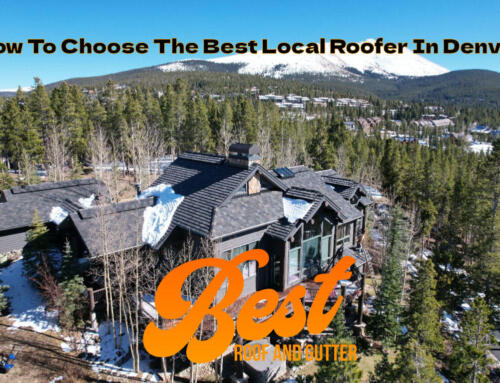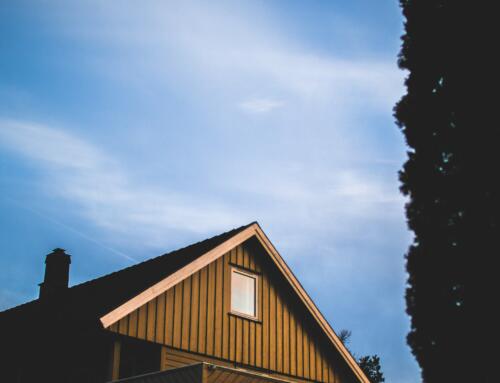There’s a simple reality that homes with steep-pitched roofs are going to cost more to install or replace a roof compared to homes with flat or low-sloped roofs. Even if the materials might be similar, a pitched roof is more difficult and dangerous to roof on. Many contractors will add a 20% or higher “pitch tax” on steeper roofs.
That being said, your roof is a critical weather barrier protecting the entire home with all your furniture and personal items inside! This is an especially important point given an average cost of a roof covering is just around 3% of the total house construction cost.
In other words, the total roof cost is a mere fraction compared to the overall cost of building a house. This is why it’s so important to choose an appropriate, quality roofing material and get it installed by a respected and trust-worthy contractor.
Flat Roof Materials vs. Pitched
On a commercial or residential flat roof, careful attention must be paid to the roofing material used. Most traditional roofing materials (shingles, tiles, corrugated metal) simply aren’t an option, because they would not be able to withstand any pooling water, which would lead to inevitable leaks. The common materials for a flat roof include EPDM rubber, PVC, TPO, BUR, tar roofs.
So how does that work in reverse for pitched roofs then? It can be somewhat “easy” to find a coating for a flat roof because your options are limited and style really isn’t a concern. Is a traditional pitched roof harder to find proper materials for simply because your choices are so wide open?
In order to find the perfect materials for a pitched roof, you need to explore which factors are most important to you:
- Aesthetics – your roofs main job is to create a barrier between your home and the weather elements. However, it also adds curb appeal to your property and can provide a better ROI when the roof is attractive and adds to the overall appearance of your home.
- Durability – the biggest factor that determines the return on your roofing investment is its life span. There are 12 year roofing materials and there are 100-year products. If you live on a coast (wind and salt water) or where you must bare the brunt of 6”-12” of snow or more at times your roof needs to be accordingly durable.
- Cost – to many homeowners the payoff for a roof is “invisible”. It’s not something you really physically enjoy like in-floor heating or a plush new couch. Essentially they think, “a roof is a roof.”Spending less money upfront can be tempting, but when you’re replacing an inferior roof every 8-10 years it becomes more costly in the long run. Then again, it’s hard to get the ROI of a 50+ year roof if you only plan on living in your home for 4-5 years. All things must be evaluated regarding cost.
In most cases your ideal roof that you are truly happy with will be a positive blend of all these factors. Finding a stylish roof that lasts long and is affordable will leave you very satisfied with your investment.
Regarding what materials to use, a lot depends on your house design and climate. Not all materials are versatile enough to match all the architectural house styles ranging from Cape Cod, Craftsman, Art Deco, Colonial, Prairie, Victorian, etc.
Each material has their climate Kryptonite so to speak; Tiles get brittle and shatter in the cold, shingles rip off in windy areas, steel roofs may corrode when installed near the coast, etc.
The great thing about pitched roofs is that you do have many options. Here is what you need to know about when it comes to selecting the right material for a pitched roof.
Asphalt Shingles
The old rhetoric is that 8 out of every 10 homes in North America are covered in asphalt shingles. Those numbers are probably shifting a bit as homeowners opt for greener roofing alternatives and modern manufacturing methods have made materials like metal tiles and standing seam more affordable (and more stylish).
It’s not hard to see how asphalt got to the top of the mountain though. It is the most affordable roofing material, installs very easily, offers decent aesthetics, and can last upwards of 20 to 30 years.
The Pros of Asphalt start with their price.
A roofing square is considered 10′ X 10′ (100 square feet) and to install asphalt shingles in some areas may cost as little as $300 to $400 per square or $3.00 to $4.00 per square foot of 3-tab or architectural shingles installed. For comparison, most other roofing materials such as metal and cedar shakes cost 2X to 4X as much. Compare that with clay or slate tiles pricing out 3X – 4X more expensive.
Do asphalt shingles improve the market value of your house and attract buyers? Not necessarily, but the money saved on a roof can be put towards flooring, countertops, and other popular renovations most homeowners are eager to do.
A lot of the cost savings from asphalt shingles also come in the labor involved with the installation. A healthy roofer on a walkable pitch can lay at least 10 squares of shingles a day. Combine that with 3-4 workers on a crew and the roof really gets installed fast.
Of course, if your roof has a steeper pitch, expect that number to drop significantly and the labor costs to rise. This is one of the reasons why it’s important to get multiple quotes to compare labor estimates.
The Cons of Asphalt have to do with their relatively ordinary style and their energy efficiency / environmental friendliness, or lack thereof. Another downfall of asphalt shingles is that they can rip apart from the nails when high winds create an uplift. Interestingly enough, if your roof has a steeper pitch, it will create more of a wall against the wind to avoid some of this damage.
As for style, asphalt shingles won’t stick out – but sometimes you don’t want that in a roof. Modern manufacturing methods have allowed for shingles that emulate slate or even wood shakes. They come in a variety of shapes such as scalloped edges (Victorian architecture) or squares (Colonial styles).
Something else you’ll notice about asphalt shingles is that they get very hot when soaking up the sun, something that transfers to your attic, and so you may well end-up with increased air-conditioning bills. Proper ventilation within the roof (your home’s attic space) is a must, but in extremely hot climates such as Texas, it may be worth investigating more energy efficient roofing options such as metal.
Metal Roofs
Credits: Anthony Wilder
Metal is perhaps the best material for homes with moderate to extremely steep pitches to their roofs. One of the biggest downfalls to installing a metal roof is that your access becomes limited because you need to know how to properly walk on a metal roof without damaging the metal tiles and their locks, and/or the material can be slippery to walk on. With a steeper roof, access usually isn’t done without the use of a ladder or sky lift (if at all) anyway.
Of course there are numerous other reasons for installing the product. In fact, metal roofing is becoming increasingly popular as evidenced by a quadrupling in market share over the past 8-10 years. There’s no sign of that surge slowing down either.
One of the biggest Pros of Metal is its durability and longevity. A metal roof can come with a lifetime guarantee and an expected life span of 30 to 50 years or more. This offers a great return on investment considering you might put 2, 3 or maybe even 4 shingle roofs on during that time depending on the pitch and local climate. Some manufacturers may even transfer the warranty on a metal roof, making it more appealing to home buyers down the line.
Metal roofing lasts so long because it is mostly impervious to the elements. This goes beyond the normal roof-batterers such as hail, wind, rain, snow, and ice, however. Metal also reflects UV rays, which helps account for its energy efficiency. Your attic stays cooler when the roof doesn’t absorb as much heat from the sun, therefore a metal roof can actually recoup some of your investment through lower utility bills, as well.
According to the National Association of Homebuilders Research Center there are 20 billion pounds of asphalt shingles that go to US dumps every year. Metal roofs offer an increased benefit to the environment over asphalt in two ways:
- About 56% of the steel is recycled and can be reused.
- Some metal roofs such as metal shingles can be installed over asphalt shingles saving landfill space.
If you’re not familiar with the concept of metal roofing, you might think the products are just sheets of steel slapped onto your home creating an eyesore. The truth is the style is one of the most underrated aspects of installing a metal roof!
The products are available not only in the traditional standing seam or corrugated sheets, but also with the looks and style of natural slate, rustic shingles, cedar shakes, barrel tiles, and more – all lightweight and eco-friendly.
On steeper roofs, metal will easily shed snow, eliminating the possibility of ice dams.
Of the Cons of Metal it’s easy to list price as #1. Having a metal roof installed on a steeper pitch home is going to cost about two to three times as much as asphalt shingles.
What’s misleading however, is that the comparison on the basis of price alone is not really fair, as metal roofs will last at least twice as long as asphalt, not too mention the curb appeal, and energy savings.
Metal roofs are in a similar price range as cedar shakes. They don’t offer the same authentic wood charm, but they do have about double the life span.
Another of the supposed downfalls of installing a metal roof is the fact that they can collect echo during loud rainstorms, however this is really only a problem for roofs of homes with no attic space.
Clay and Concrete Tiles
There’s a slippery slope when it comes to installing clay and concrete tiles on a roof with a steep pitch. On one hand, the materials are so heavy that some expensive structural enhancements of the roof frame may need to be done in order to support the extra weight.
On the flip side though, the tiles last so long that once the extensive project is completed, it will likely be the last roof you’ll ever have installed.
There are some Pros of Clay and Concrete Tiles pertaining especially to pitched roof styles. One example has to deal with the durability of the materials.
Since clay and concrete can stand up to the elements so well, it’s easy to assume that they can withstand walking on too. That’s not the case though as the tiles will easily crack under the pressure of somebody accessing the roof to repair a chimney, fix a satellite dish, etc. Homeowners and repair techs usually don’t access a pitched roof often, so tiles make for a great roofing material.
Italian and Spanish style homes are the most traditional options for clay and concrete tiles. The products need little maintenance which is ideal for a pitched roof, although they have been known to attract lichens and moss. If you can’t access the pitched roof it may be hard to clean the moss. The good thing is that most of the damage is only aesthetic instead of structural.
The Cons of Clay and Concrete Tiles depend on which material you opt to put on your roof. They are not one category, the materials are actually different. Concrete (or cement) is a little more affordable whereas clay is more durable. The styles are similar, so consumers need to evaluate if the $1,200-$1,400 cost per square of the longer lasting clay tiles outweighs the $700-$1,200 concrete tile installation price tag.
Slate Tiles

Slate is arguably the most ideal roofing material for a high-pitched roof (provided your roof-frame has has sufficient reinforcement to carry the weight of sale) – if your budget can afford it. Unfortunately with slate, the cost can be up to 5X of other roofing materials.
Slate is a rarity to be installed, which means the number of contractors experienced with the material – especially on heavily-pitched roofs – is minimal.
The Pros of Slate Tiles start with their looks. There’s a reason why shingles, tiles, and metal roofs try to emulate the looks of slate and nothing compares to the authentic. The slate / stone look looks great on older homes as well as modern ones.
With some roofing materials such as cedar shakes and asphalt shingles you may have to replace it 3-4 times in a lifetime. Slate on the other hand can last 3-4 different lifetimes with 100+ year lifespans being the norm.
Slate is expensive, true but it’s also the only roof you, your children, and grandchildren will likely ever have to install on the home. Of course, it can be hard to justify the ROI when you’re not going to be around to see it but it is something that future buyers would take into consideration if you sell.
For as great of a material that it is there are still some significant Cons of Slate Tiles as well. First is the price which can range from $1,000 to $2,000 per square to install simply isn’t feasible for most budgets. A slate roof will likely recoup most of its cost on the right house, but it’s hard to justify spending $30,000 on a roof for a $60,000 house.
Slate is also very heavy which requires some pretty extensive structural enhancements within your home to accept the weight. Replacing slate with slate is simple, but going from shingles to slate may require some pretty advanced renovations – which the difficulty is compounded on a pitched roof.
You may love the slate look on your house and have the budget available, but there could still be one thing hindering your purchase – finding a specialist contractor to install the product.
Slate is simply too valuable to be installed by somebody who is not experienced in the craft. Since it’s such a rarity, most contractors could spend 40-50 years in the roofing industry without ever laying one slate roof!
Other, Pitched Roofing Materials
To find the ideal roofing material for a home with a pitched roof you want something that is low maintenance and long lasting. If you happen to like the style and it fits in your budget those are essentially bonuses. Some other materials to consider include:
- Cedar Shakes – wood roofs offer a very authentic look but they are hit or miss for many homeowners with pitched roofs.First of all, cedar shingles and shakes require regular maintenance to expand their life span – something that isn’t always easy to accomplish with limited access. Even then the longevity of most cedar roofs are the lowest of any material types while the price is about 3X higher than the most affordable.
- Fiber Cement – definitely worth a look for pitched roofs. The composite material is most commonly used as siding but the longevity and style options are expanding the popularity of use on roofs. The mixture of sand, cement, and cellulose fibers resists weather, insects, mold, and has a life span of 50+ years
The best plan of attack for finding materials for your pitched roof is to get multiple quotes over a variety of different roofing types. You’ll have an example of material costs and see how much on average contractors are “upcharging” for your particular roofing pitch.
The prices may seem high, but remember that on a steeply pitched roof it takes about three moves just to make one. Plus, the alternative is a DIY job and that’s nowhere near as fun as it sounds on a steep roof.
Call Today (720) 443-5386 or get a free estimate from Best Roof And Gutter!

